With widespread water scarcity, deforestation, urban chaos, pollution and global warming having transformed into everyday realities, there’s a new urgency to transform the reach and content of environment education in schools and colleges across the country. Summiya Yasmeen reports
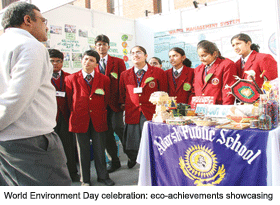 On June 5, designated World Environment Day by the United Nations in 1972, there will be resounding unanimity among politicians, bureaucrats, activists, well-heeled citizens of urban India and principals of traditional and new gen schools and colleges, that there is urgent need to arrest the steady decline of India’s ecology and environment. As usual, the day will be marked by students participating in tree plantation programmes, performing skits highlighting human damage to the environment, staging of protests and sloganeering, and planting of saplings on institutional campuses. Almost every school and college — government and private — in the country, which has hopped aboard the green bandwagon, will showcase their eco-achievements on June 5.
On June 5, designated World Environment Day by the United Nations in 1972, there will be resounding unanimity among politicians, bureaucrats, activists, well-heeled citizens of urban India and principals of traditional and new gen schools and colleges, that there is urgent need to arrest the steady decline of India’s ecology and environment. As usual, the day will be marked by students participating in tree plantation programmes, performing skits highlighting human damage to the environment, staging of protests and sloganeering, and planting of saplings on institutional campuses. Almost every school and college — government and private — in the country, which has hopped aboard the green bandwagon, will showcase their eco-achievements on June 5.
However, beyond celebrating World Environment Day, credit needs to be given to most school examination boards — particularly the CBSE and CISCE — for mandating environment education (EE) as a compulsory subject in their syllabuses. But although in their eco-enthusiasm the boards have introduced EE — a trendy, hip subject — the focus is on theoretical concepts rather than real ecology issues. With widespread water scarcity, deforestation, urban chaos, pollution and global warming having transformed into everyday realities, there’s a new urgency to transform the reach and content of environment education in schools and colleges across the country.
The data bank of environment horror statistics is building up fast. For instance, India’s per capita surface water availability has plummeted from 2,309 cm (cubic metres) in 1991 to 1,902 cm in 2001 and is projected to fall to 1,401 cm in 2025; global warming has caused the average summer temperatures to rise from 30°C to 34°C in Delhi during the period 1995-2005; according to the Wildlife Institute of India (WII), the number of tigers in the country has dwindled by half in three years to 1,411 currently. Moreover the UN’s World Water Development Report (2005) predicts depleting availability of freshwater, describing the situation for future generations as severe.
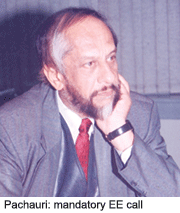 Comments Dr. R.K. Pachauri, director general of the Delhi-based The Energy and Resources Institute (TERI) and chairman of the Intergovernmental Panel on Climate Change (IPCC), who shared the Nobel Peace Prize in 2007 with former US vice-president Al Gore for helping focus world attention on the challenges posed by man-made climate change: “Making environment education mandatory in schools has enormous potential for transforming Indian society towards greater environmental consciousness and sustainable development. Youth, and especially children who are the leaders of tomorrow, in their role as Green Ambassadors, can be major agents of change for a sustainable future. TERI has come a long way in strengthening human and institutional capacity on nature conservation and environmental protection, with the help of environment education and allied activities. It is time for our younger generation to find new solutions to save Planet Earth and adopt a new approach in which economic growth complements the environment.”
Comments Dr. R.K. Pachauri, director general of the Delhi-based The Energy and Resources Institute (TERI) and chairman of the Intergovernmental Panel on Climate Change (IPCC), who shared the Nobel Peace Prize in 2007 with former US vice-president Al Gore for helping focus world attention on the challenges posed by man-made climate change: “Making environment education mandatory in schools has enormous potential for transforming Indian society towards greater environmental consciousness and sustainable development. Youth, and especially children who are the leaders of tomorrow, in their role as Green Ambassadors, can be major agents of change for a sustainable future. TERI has come a long way in strengthening human and institutional capacity on nature conservation and environmental protection, with the help of environment education and allied activities. It is time for our younger generation to find new solutions to save Planet Earth and adopt a new approach in which economic growth complements the environment.”
TERI’s environment education and awareness unit organises regular programmes and workshops for schools and colleges to sensitise and spread awareness about eco-challenges and how students can address them. During this summer vacation, TERI opened up its library in Delhi to students between five and 15 years, to enable them to access, read and learn about climate change.
The importance of environment education in schools was first formally acknowledged by the Supreme Court in 2004. While hearing a PIL (public interest litigation) filed by well-known environmentalist and Supreme Court lawyer M.C. Mehta in 1991, it directed the Central and state governments to introduce EE as a compulsory subject in all schools countrywide. Subsequent to the apex court judgement, the Union human resource development (HRD) ministry issued a circular to the 10,025 schools affiliated with the Central Board of Secondary Education (CBSE) to introduce EE as an academic subject in secondary school (classes VIII-XII). The pan-India Council of Indian Secondary Certificate Examinations (CISCE) also followed suit, directing the 1,699 schools affiliated with it to introduce EE as a compulsory subject in classes I-XII.
Moreover some state level examination boards like the Maharashtra board also made environment education compul-sory. Thus over the past four years EE has been adopted by most schools either as an extra-curricular programme, or compulsory academic subject
“After the Supreme Court order, environment education has become compulsory in schools as well as colleges. Some states have done well to implement it, others are doing so. The Union ministry of environment and forests is helping them implement environment education effectively. In some cases it is part of students’ project work while in other schools it is in the curriculum, hence, linked to evaluation. But there is always scope for strengthening environment education both through formal and informal means,” says Rajendra Mehta, a Delhi-based environment education advisor to the Union ministry of environment and forests.
Although the Union and state governments had to be prompted by NGOs and the apex court to introduce EE into school syllabuses, and all Central government and most state examination boards have complied, the content and classroom delivery of EE has come under heavy fire from eco-educators and campaigners for being rote learning-centred rather than activity-oriented.
A 2003 study conducted by the Pune-based Bharati Vidyapeeth Institute for Environmental Education and Research on the ‘Status of infusion of environmental concepts in school curricula and the effectiveness of its delivery’, found that the teaching of environmental concepts in classrooms is divorced from real life experiences. The study, sponsored by the Union ministry of environment and forests and the World Bank (which covered 800 schools countrywide), found that the textbooks provided “very poor information on sustainable lifestyles and what individuals could and should do for environmental preservation through their personal daily activities”. “As happens often with other components of school curricula, EE too has become a subject to be learnt by rote, without the students understanding or caring enough for the subject matter,” say the authors of the report.
A cursory examination of the EE textbooks prescribed by the CBSE and CISCE boards for the academic year 2008-09 by your correspondent suggests that not much has changed since 2003. The textbooks’ focus continues to be on the theoretical aspects of the natural life cycle and environment conservation rather than acquisition of practical skills and advice on how to regenerate human and natural environments. For instance, in the EE textbook edited by Dr. A.N. Rai (Goyal Brothers Parkashan, 2009) for class XII students of the CISCE board, the chapter on ‘sustainable development’ comprises only definitions, causes and effects, and lists international summits and conventions, without any locale-specific examples or advice provided to students on how they can do their bit to improve the quality of life of people living in their neighbourhoods.
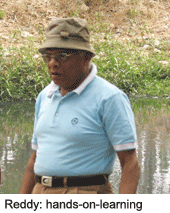 According to Yellappa Reddy, former secretary of the department of ecology and environment, government of Karnataka, and a well-known Banga-lore-based environmentalist, the EE textbooks prescribed by the CBSE and CISCE boards are “wholly inadequate”. “There is no real environment education happening in schools — private or government. The syllabus and textbooks are such that students only mug up and regurgitate definitions and environment disaster facts in year-end exams. A holistic and integrated approach to environment education requires involvement of students in hands-on-learning activities. For instance schools could encourage students to plant saplings in their campuses, tend and watch them grow. Moreover every school should build a small lab equipped with basic instruments to impart hands-on learning. Environment education cannot be taught only in classrooms; children need to experience the joys of nature to be motivated to appreciate and conserve its bounty. Involving children in real environment issues, and encouraging them to find solutions, is the best pedagogy for creating ecologically aware citizens, sensitive to the needs of Mother Nature, “ says Reddy.
According to Yellappa Reddy, former secretary of the department of ecology and environment, government of Karnataka, and a well-known Banga-lore-based environmentalist, the EE textbooks prescribed by the CBSE and CISCE boards are “wholly inadequate”. “There is no real environment education happening in schools — private or government. The syllabus and textbooks are such that students only mug up and regurgitate definitions and environment disaster facts in year-end exams. A holistic and integrated approach to environment education requires involvement of students in hands-on-learning activities. For instance schools could encourage students to plant saplings in their campuses, tend and watch them grow. Moreover every school should build a small lab equipped with basic instruments to impart hands-on learning. Environment education cannot be taught only in classrooms; children need to experience the joys of nature to be motivated to appreciate and conserve its bounty. Involving children in real environment issues, and encouraging them to find solutions, is the best pedagogy for creating ecologically aware citizens, sensitive to the needs of Mother Nature, “ says Reddy.
Pamela Gale Malhotra, the Coorg-based promoter-trustee of SAI (Save Animals Initiative) Sanctuary Trust, an NGO which has been organising nature awareness programmes for school and college students for the past ten years, seconds Reddy’s plea for a holistic and integrated approach to environment education.
 “Teaching environment education as a boring academic subject is the surest way to kill children’s enthusiasm for nature and the environment. It’s a subject which involves real issues which, if not addressed and solved, can drastically threaten the very existence of Planet Earth. Schools must adopt an integrated pedagogy to create enthusiasm within children to preserve our ecology and environment. A first step is to bring children in contact with nature and wildlife, not by way of picnics and games, but by way of site studies. Field trips will help them understand how nature works and how human beings are disturbing nature’s balance. This can be followed by establishing student-run plant nurseries in schools with children encouraged to take ownership of nurseries, protecting and nurturing them. The next step is to encourage students to move to planting trees in the school neighbourhood. Such practical, hands-on EE will help create caring, sensitive and ecologically-aware citizens,” says Malhotra, whose SAI recently organised a nature awareness programme for students on its 300-acre sanctuary in Coorg in the Western Ghats.
“Teaching environment education as a boring academic subject is the surest way to kill children’s enthusiasm for nature and the environment. It’s a subject which involves real issues which, if not addressed and solved, can drastically threaten the very existence of Planet Earth. Schools must adopt an integrated pedagogy to create enthusiasm within children to preserve our ecology and environment. A first step is to bring children in contact with nature and wildlife, not by way of picnics and games, but by way of site studies. Field trips will help them understand how nature works and how human beings are disturbing nature’s balance. This can be followed by establishing student-run plant nurseries in schools with children encouraged to take ownership of nurseries, protecting and nurturing them. The next step is to encourage students to move to planting trees in the school neighbourhood. Such practical, hands-on EE will help create caring, sensitive and ecologically-aware citizens,” says Malhotra, whose SAI recently organised a nature awareness programme for students on its 300-acre sanctuary in Coorg in the Western Ghats.
Although getting children out of classrooms and into forests and wildlife sanctuaries is important for creating ecologically sensitive citizens, a growing number of environment activists plead for a balance between academic inputs and hands-on field work. They argue that EE syllabuses should be a blend of multidisciplinary inputs including site and field visits. In particular, this is the opinion of the Delhi-based Centre for Science and Environment (CSE), a public interest research and advocacy NGO founded in 1980 by the late and legendary ecologist/environmentalist Anil Agarwal. In 2005, CSE established a fully-fledged environment education unit which has been given the mandate of “producing quality resource materials and programmes to bring about a more ecologically conscious way of thinking and living” for secondary schools and institutions of higher education.
 To attain this objective, in 2005, CSE launched its unique Green Schools Programme (GSP) to help students conduct ‘environment audits’ of school campuses. Under GSP, students are trained to evaluate and assess their own school’s environmental sensitivity and practices (e.g how much water does the school consume? How is it managing its wastewater?). Data collected is tabulated and analysed with the help of teachers. Based on final reports submitted to CSE, schools with the best environmental practices are presented Green Schools Awards at an annual ceremony held in Delhi (see box p.70). Currently GSP covers 5,500 schools countrywide.
To attain this objective, in 2005, CSE launched its unique Green Schools Programme (GSP) to help students conduct ‘environment audits’ of school campuses. Under GSP, students are trained to evaluate and assess their own school’s environmental sensitivity and practices (e.g how much water does the school consume? How is it managing its wastewater?). Data collected is tabulated and analysed with the help of teachers. Based on final reports submitted to CSE, schools with the best environmental practices are presented Green Schools Awards at an annual ceremony held in Delhi (see box p.70). Currently GSP covers 5,500 schools countrywide.
“The green schools programme is an unique initiative which has helped students address real ecology issues within their immediate environments. Its uniqueness is that it reverses the traditional practice of schools assessing students and requires students to prepare a report card on their school, assessing its environment performance. The audit is conducted with the help of a specially prepared handbook — the Green Schools Programme Manual — which provides step-by-step instructions on how to conduct an environmental audit. This is a national movement with the number of participating schools, having grown from 1,200 in 2006 to 5,500 currently,” says Sumita Dasgupta, the Delhi-based coordinator of CSE’s environment education unit.
Apart from the Green Schools Programme, CSE conducts workshops for teachers to help them incorporate environment awareness and learning into their subjects. To this end, it has also prepared an Ecological Footprint Manual to help teachers and parents conduct eco-tours for children; and also publishes Gobar Times, an environ-ment focused monthly magazine for teachers and children.
Among CSE’s 15 Green School Awards 2008 recipients is the Delhi-based Sri Ram School (SRS), ranked India’s most respected day school in the EducationWorld-Cfore Schools Survey 2008, which has won encomiums from CSE for implementing several eco-friendly practices and initiatives on its 15 acre campus in Delhi. A pioneer of rooftop rain water harvesting since 1999, it saves and utilises 3.44 million litres of rain water annually from the school’s roofs and surface areas. Moreover SRS hosts a massive vermiculture pit in which institutional waste is transformed into valuable organic manure used to maintain the school’s immaculate lawns and gardens.
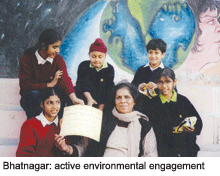 Encouraged and supported by the management, and environment education teacher Madhu Bhatnagar in particular, SRS’ Junior Green Brigade (JGB), a group of young and enthus-iastic environmentalists, is actively engaged in keeping school premises clean and implementing awareness campaigns against firecrackers and the use of polythene bags. Moreover, when in 2005 the Sariska Tiger Sanctuary in Rajasthan reported alarming depletion of its population, JGB devised a detailed action plan to save the tiger population of the neighbouring Ranthambore National Park. A Junior Tiger Task Force was immediately set up and an appeal was made to the prime minister asking for government inter-vention to protect the tiger.
Encouraged and supported by the management, and environment education teacher Madhu Bhatnagar in particular, SRS’ Junior Green Brigade (JGB), a group of young and enthus-iastic environmentalists, is actively engaged in keeping school premises clean and implementing awareness campaigns against firecrackers and the use of polythene bags. Moreover, when in 2005 the Sariska Tiger Sanctuary in Rajasthan reported alarming depletion of its population, JGB devised a detailed action plan to save the tiger population of the neighbouring Ranthambore National Park. A Junior Tiger Task Force was immediately set up and an appeal was made to the prime minister asking for government inter-vention to protect the tiger.
“With members of the Junior Tiger Task Force, I visited Sawai Madhopur (the village bordering Ranthambore), met with forest guards, environ-mentalist Fateh Singh Rathore of NGO Tiger-Watch and Rajmal Moghiya, a reformed poacher, to devise a strategy to save the reserve’s tiger population. Subsequently we launched the Moghiya Rehabilitation Programme, which involved construction of Moghiya Hostel for children of forest guards, and started the Guggal (an anti-inflammatory medicinal plant) Plantation of 2,500 trees,” recalls Bhatnagar who has a simple message for environmental education teachers: “We will conserve only what we love. We will love what we understand. We will understand what we are taught.”
Although not as spectacular as Sri Ram School’s eco initiatives, two Pune schools — Vidya Valley and Aman Setu — have generated considerable environmental awareness within this industrial city (population: 5 million) by persuading their managements to ban cars, auto-rickshaws, tempos and buses from entering their campuses. Moreover the ICSE-affiliated Vidya Valley School has made it compulsory for all its 875 students to compulsorily commute on the school’s 18 buses. “This initiative was taken to encourage the pooling concept, reducing the carbon footprint as well to promote social equality. About 100 students used to come daily in private cars. This amounts to a criminal waste of fuel and adds to the city’s already high carbon emissions and pollution levels. Now with all students using school buses for commuting, carbon emissions and fuel consumption have been reduced,” says Nalini Sengupta, principal, Vidya Valley School.
In the CISCE board-affiliated Aman Setu School (estb. 2001), which has an aggregate enrolment of 250 students up to class IV, several innovative eco-friendly practices have been introduced. Promoted by the Pune-based Madhavi Kapur Foundation and sited in Wagholi, 10 km from Pune, the school is set amidst emerald green fields and housed in a stone farmhouse, with all buildings constructed of bamboo and earthbag — a mixture of earth, sand, grit and minimal cement. “At Aman Sethu, our endeavour is to provide children the opportunity to learn and develop in a natural environment. That’s why the school was built using eco-friendly materials. We want to share our experience of building a green school and environmental best practices with other schools. Therefore we have published Earthbags, a booklet which suggests eco-alternatives, neo-conventional construction practices and addresses issues concerning sustainable development and resource consumption,” says Madhavi Kapur, director of the school.
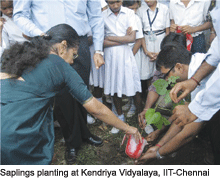 Awareness about the importance of integrated EE, which supplements textbook lessons with action plans, is spreading countrywide. Down south, the Central government-run Kendriya Vidyalaya, sited in the IIT-Chennai campus in this southern port city, has also adopted a holistic approach to environment education by exposing students to ecology issues such as the greenhouse effect and global warming through cultural programmes and co-curricular activities including quiz and essay writing competitions. “In our environment education curriculum, we try to strike a balance between classroom teaching and practical activities. We motivate students to participate in seminars, interact with eminent scientists and are encouraging them to maintain a botanical garden on the campus. Our school is also a member of the Green Olympiad Foundation, a pan-India organisation which organises a national level exam on environment issues and quiz competitions,” says N Mohanasundaram, principal of Kendriya Vidyalaya, IIT-Chennai.
Awareness about the importance of integrated EE, which supplements textbook lessons with action plans, is spreading countrywide. Down south, the Central government-run Kendriya Vidyalaya, sited in the IIT-Chennai campus in this southern port city, has also adopted a holistic approach to environment education by exposing students to ecology issues such as the greenhouse effect and global warming through cultural programmes and co-curricular activities including quiz and essay writing competitions. “In our environment education curriculum, we try to strike a balance between classroom teaching and practical activities. We motivate students to participate in seminars, interact with eminent scientists and are encouraging them to maintain a botanical garden on the campus. Our school is also a member of the Green Olympiad Foundation, a pan-India organisation which organises a national level exam on environment issues and quiz competitions,” says N Mohanasundaram, principal of Kendriya Vidyalaya, IIT-Chennai.
Likewise, the overwhelming majority of the country’s 10,025 CBSE-affiliated schools, including the Central government-sponsored 981 KVs and 576 Jawahar Navodaya Vidyalayas, are members of the Union ministry of environment and forests’ National Green Corps (NGC). Administered by the Union government-backed Centre for Environment Education (CEE), under the NGC initiative, eco-clubs are promoted in CBSE schools with the objective of encouraging environment-related activities for students. Thus far, around 150 eco-clubs have been set up in each of the 28 states and seven union territories.
Promoted in 1984 by the Union ministry of environment and forests, CEE has five regional cells in Bangalore, Lucknow, Guwahati, Pune and Ahmedabad, and provides environment education resources and inputs to over 32,300 schools countrywide. Currently CEE runs several initiatives such as the Strengthening Environmental Education in the School System Programme (which helps infuse environmental concepts into school curricula); the Educational Programme on Science and Environment (to develop and coordinate resources for teaching environmental sciences); and coordinates the Global Learning and Observations to Benefit the Environment (GLOBE), a worldwide hands-on internet-based science and environment education programme in partnership with the National Aeronautical and Space Agency (NASA), USA. Over 20,000 schools all over the world, of which 939 are in India, are enrolled in the GLOBE programme.
 Undeniably NGOs such as CEE and Centre for Science and Environment deserve to be given full credit for stepping up to advise confused school managements on ways and means to expand and integrate environment education into their curriculums, and creating awareness of the looming crisis of environmental degradation. Although perhaps not fast enough, environment education is gradually moving up on the agenda of schools, colleges and institutions of higher learning. “There’s an urgent need for schools to mainstream environment education and integrate it into the learning and teaching process by connecting it to live environmental issues. The world is facing grave ecological threats — vital water and energy scarcity, waste and land use conflicts. A society cannot survive if its natural resources are rendered unfit for use by its people. Therefore, children and youth must be fully encouraged to proactively contribute to finding solutions to protect the environment they will inherit,” says Sumita Dasgupta, the Delhi-based of coordinator of CSE’s environment education unit.
Undeniably NGOs such as CEE and Centre for Science and Environment deserve to be given full credit for stepping up to advise confused school managements on ways and means to expand and integrate environment education into their curriculums, and creating awareness of the looming crisis of environmental degradation. Although perhaps not fast enough, environment education is gradually moving up on the agenda of schools, colleges and institutions of higher learning. “There’s an urgent need for schools to mainstream environment education and integrate it into the learning and teaching process by connecting it to live environmental issues. The world is facing grave ecological threats — vital water and energy scarcity, waste and land use conflicts. A society cannot survive if its natural resources are rendered unfit for use by its people. Therefore, children and youth must be fully encouraged to proactively contribute to finding solutions to protect the environment they will inherit,” says Sumita Dasgupta, the Delhi-based of coordinator of CSE’s environment education unit.
Undoubtedly there is growing awareness within Indian academia — and society in general — about the vital importance of environment education. However the weight of evidence indicates that environment education is imparted in an off-hand, ritualistic, rather than structured manner as in developed nations including the People’s Republic of China (see box). In particular the quality of environment education dispensed in the country’s 1.20 million government schools, which dispense low-quality education to 90 percent of the country’s school children, is desultory.
Even as India’s population continues to rise by a net rate of 1.44 percent per year and the pressure on the country’s dwindling resources intensifies, one of the top priorities of the newly elected Congress-led UPA government, which is all set to begin a new term of office in New Delhi, will be to accord increasing form and content to environment education dispensed in the country’s schools and colleges. Beneath the veneer of the India Shining story, India’s climate and ecology are inexorably sliding into danger zones.
With Autar Nehru (Delhi); Hemalatha Raghupathi (Chennai); Anjana Pradhan (Bangalore) & Huned Contractor (Pune)